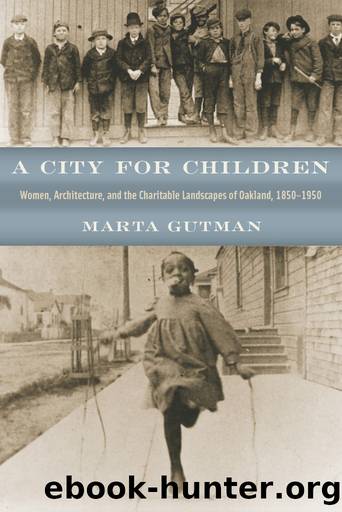A City for Children by Marta Gutman

Author:Marta Gutman [Gutman, Marta]
Language: eng
Format: epub
Publisher: University of Chicago Press
Published: 2014-06-15T00:00:00+00:00
Figure 7.13. Women distributing pure milk in front of the West Oakland Free Kindergarten, c. 1912. Courtesy of Oakland Public Library, Oakland History Room.
EIGHT
Orphaned in Oakland: Institutional Life during the Progressive Era
On September 7, 1905, Arthur J. Pillsbury left California for a trip east. At the request of the governor, George C. Pardee, he planned to visit more than eighty institutions housing orphaned, sick, handicapped, unruly, and otherwise needy boys and girls in the Midwest and the Northeast. Among the organizers of the Lincoln-Roosevelt League, the reform wing of the stateâs Republican Party, Pillsbury and Pardee were as determined as any California progressive to free state government from the undue influence of the Southern Pacific Railroad. For Pillsbury, at least, that step was necessary to activate the âNew England conscience in government.â1 Another pressing matter also sent him east, one as important to reformers as redeeming government from corporate domination. A political crisis was brewing. The governor faced public outcry about child welfare, with special outrage directed at two separate issues that became intertwined in state politics: the soaring cost to taxpayers of caring for children in private orphanages, and the rampant physical abuse of kids held in state-run reform schools.2 To divert attention from the scandal and toward reform, the progressive cohort in Sacramento sent Pillsbury on this fact-finding mission, to find better models for philanthropic practice elsewhere in the nation.
The governorâs envoy came with useful credentials. Executive secretary to the State Board of Examiners, Pillsbury was born in New Hampshire in 1854; his father, an abolitionist, moved his family to âbleedingâ Kansas later that year to join the campaign to make the territory a free state. The younger Pillsbury studied law and, although admitted to the bar, turned to journalism after moving with his wife to California in 1881.3 Since the stateâs board of examiners audited the Orphan Fund of California, Pillsbury grasped the central role of government in the stateâs mixed economy of social welfare: the board allocated state aid to forty-four orphanages and fifty-eight county boards of supervisors. In 1905 it sent hundreds of thousands of dollars to 7,301 children: 5,283 in orphanages and 2,018 through county supervisors. Another 1,230 children also lived in the stateâs orphanages without support from the state government.4 Mindful of the pledge to safeguard children that had been written into the state constitution during the 1879 convention, Pillsbury reminded the public of that responsibility. During his trip he sent the governor informal reports which were polished into press releases and sent to obliging editors who published them in newspapers across the state.5
One year later, Pillsbury summed up his findings in Institutional Life: Its Relations to the State and to the Wards of the State. âIn California, dependent childhood is mainly a state problem, as it should be,â he wrote, alluding to the historic pattern of care in the state and the new Progressive ideal of the state as parent.6 Like other reformers, he was willing to abrogate a parentâs traditional right
Download
This site does not store any files on its server. We only index and link to content provided by other sites. Please contact the content providers to delete copyright contents if any and email us, we'll remove relevant links or contents immediately.
| Americas | African Americans |
| Civil War | Colonial Period |
| Immigrants | Revolution & Founding |
| State & Local |
In Cold Blood by Truman Capote(3349)
The Innovators: How a Group of Hackers, Geniuses, and Geeks Created the Digital Revolution by Walter Isaacson(3009)
Steve Jobs by Walter Isaacson(2864)
All the President's Men by Carl Bernstein & Bob Woodward(2348)
Lonely Planet New York City by Lonely Planet(2200)
And the Band Played On by Randy Shilts(2169)
The Room Where It Happened by John Bolton;(2135)
The Poisoner's Handbook by Deborah Blum(2112)
The Murder of Marilyn Monroe by Jay Margolis(2080)
The Innovators by Walter Isaacson(2076)
Lincoln by David Herbert Donald(1968)
A Colony in a Nation by Chris Hayes(1905)
Being George Washington by Beck Glenn(1788)
Under the Banner of Heaven: A Story of Violent Faith by Jon Krakauer(1768)
Amelia Earhart by Doris L. Rich(1673)
The Unsettlers by Mark Sundeen(1661)
Dirt by Bill Buford(1651)
Birdmen by Lawrence Goldstone(1641)
Zeitoun by Dave Eggers(1622)
